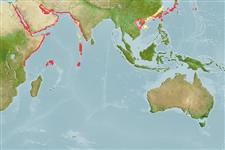>
Ovalentaria/misc (Various families in series Ovalentaria) >
Pomacentridae (Damselfishes) > Pomacentrinae
Etymology: Amphiprion: Greek, amphi = on both sides + Greek, prion, -onos = saw (Ref. 45335).
More on author: Rüppell.
Environment: milieu / climate zone / profondeur / distribution range
Écologie
marin récifal; non migrateur; profondeur 1 - 30 m (Ref. 9710). Tropical; 31°N - 7°S
Western Indian Ocean: Red Sea and Chagos Archipelago.
Taille / Poids / Âge
Maturité: Lm ? range ? - ? cm
Max length : 14.0 cm TL mâle / non sexé; (Ref. 9710)
Description synthétique
Clés d'identification | Morphologie | Morphométrie
Épines dorsales (Total) : 9 - 10; Rayons mous dorsaux (Total) : 15 - 17; Épines anales: 2; Rayons mous anaux: 13 - 14. Yellow orange with 2 black-edged white bands, the first running just behind the head, the second from the notch between the spinous and soft dorsal fin to the abdomen.
Body shape (shape guide): short and / or deep; Cross section: compressed.
Life cycle and mating behavior
Maturité | Reproduction | Frai | Œufs | Fécondité | Larves
Oviparous, distinct pairing during breeding (Ref. 205). Monogamous mating is observed as both obligate and social (Ref. 52884). Eggs are demersal and adhere to the substrate (Ref. 205). Males guard and aerate the eggs (Ref. 205). Sex reversal is completed in 26-145 days (Ref. 34185). In a field test, a functional male laid eggs in 26 days after removal of the female from the area (Ref. 240, 32167).
Allen, G.R., 1991. Damselfishes of the world. Mergus Publishers, Melle, Germany. 271 p. (Ref. 7247)
Statut dans la liste rouge de l'IUCN (Ref. 130435: Version 2025-1)
Menace pour l'homme
Harmless
Utilisations par l'homme
Pêcheries: commercial; Aquarium: Commercial
Outils
Articles particuliers
Télécharger en XML
Sources Internet
Estimates based on models
Preferred temperature (Réf.
123201): 24.6 - 29.1, mean 27.4 °C (based on 589 cells).
Phylogenetic diversity index (Réf.
82804): PD
50 = 0.5000 [Uniqueness, from 0.5 = low to 2.0 = high].
Bayesian length-weight: a=0.02344 (0.01134 - 0.04848), b=2.98 (2.80 - 3.16), in cm total length, based on LWR estimates for this (Sub)family-body shape (Ref.
93245).
Niveau trophique (Réf.
69278): 2.7 ±0.30 se; based on food items.
Résilience (Réf.
120179): Haut, temps minimum de doublement de population inférieur à 15 mois (Preliminary K or Fecundity.).
Fishing Vulnerability (Ref.
59153): Low vulnerability (10 of 100).
🛈
Nutrients (Ref.
124155): Calcium = 93.7 [47.6, 145.6] mg/100g; Iron = 0.71 [0.44, 1.15] mg/100g; Protein = 18.2 [17.1, 19.4] %; Omega3 = 0.109 [0.069, 0.174] g/100g; Selenium = 25.1 [14.3, 45.9] μg/100g; VitaminA = 80.2 [22.4, 269.2] μg/100g; Zinc = 1.63 [1.12, 2.34] mg/100g (wet weight);
